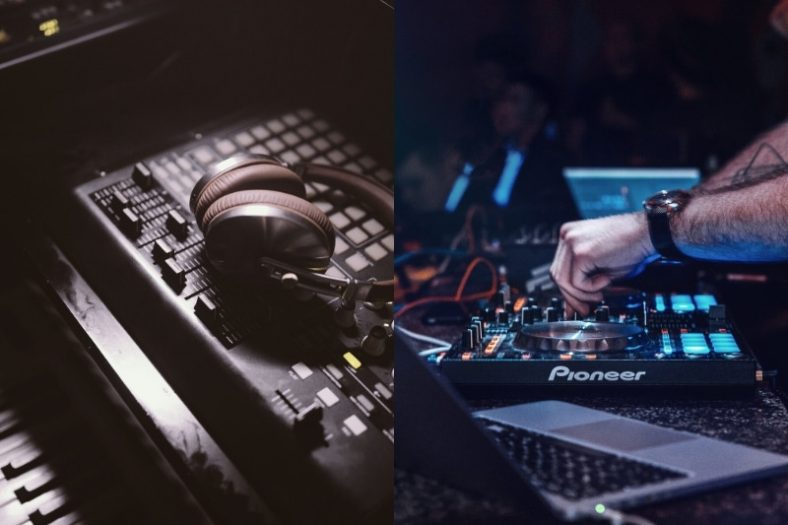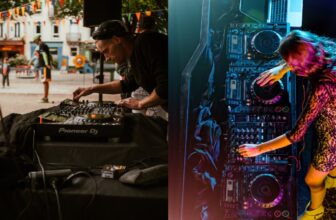DJ Set vs Live Set – What’s the Difference?

In a DJ set, the artist simply mixes pre-recorded tracks with a turntable and/or DJ program, whereas in a live set the artist performs live songs with a laptop, synths, MIDI controllers, and/or acoustic instruments. Live sets are ordinary live music performances featuring electronic elements.
The English electronic music duo Disclosure makes for a good example to illustrate the differences between a DJ set and a live set. In their Shanghai Boiler Room DJ set, they can be seen combining pre-recorded audio tracks with a turntable. In their 2021 Reading live set, on the other hand, they are performing their songs live alongside a full brass section.
Some people have a hard time distinguishing DJ sets from live sets because both employ electronic-music elements. When they see an artist performing live with a laptop, for instance, they tend to assume he or she is always doing the same thing. However, that’s not the case.
Contents
What do artists do in a DJ set?
In a DJ set, artists use a turntable or DJ program to mix pre-recorded tracks. To prepare for a DJ set, they select a few audio files that fit well together (usually .wav files) and combine them using a crossfader, looping, and audio effects. It’s common for DJ-set artists to play songs by other artists in addition to their songs.
When performing live, DJ-set artists hit play on pre-recorded tracks, twist some knobs to change their sonic character, and switch from track to track using a crossfader. While some DJs do play drum beats or melodic passages over their songs, DJ sets don’t usually include any element commonly associated with a live-music performance.
In other words, DJs don’t need to know how to play an instrument to perform live. DJing is an art form in itself that mainly revolves around the ability to select and combine tracks flawlessly.
What do artists do in a live set?
Outside the electronic music niche, it’s pretty easy to distinguish a DJ set from a live set. Live sets are ordinary live music performances, featuring one or more musicians who play an instrument in front of an audience. But what do electronic music artists do when they’re playing a live set?
When you see an artist performing live with a laptop, it’s easy to assume that—just like a DJ—he or she is simply combining pre-recorded tracks in a controlled setup. In a way, this might be true. Electronic-music live sets tend to include pre-recorded samples, albeit in the form of music stems, not complete songs.
However, DJs and live artists perform entirely different functions on stage, whether they’re using the same resources (such as a laptop) or not. While DJing is about combining full songs, electronic-music live sets revolve around a DAW project with short samples, virtual instruments, and audio effects that can be controlled via MIDI.
These DAW projects are fully customizable, meaning it’s up to each artist to make his or her own. Some electronic-music artists will simply map their projects to a MIDI controller to launch scenes (i.e., play certain music passages), combine different samples, and do some live effect processing. Others go the extra mile and use keyboards and drum pads to play virtual instruments and drums in front of an audience.
AraabMuzik’s minimalistic approach to a live set, for instance, revolves around playing one or more MPC controllers live in finger-drumming style. While the sounds that come out of his MPC are pre-recorded audio snippets (one-shot samples), there’s no denying that he’s playing his electronic controllers as if they were real instruments. His Paradiso Amsterdam live set is worth watching.
Equipment used in a DJ set
When it comes to DJ sets, the turntable is king. DJs use turntable decks to play one song on one side and another song on the other. This way, they can move from song to song without the music stopping. Turntable decks are also used to play two or more songs simultaneously. Experienced DJs may take this a step further, using four, six, or even eight different decks.
Aside from the mighty turntable, DJs can perform in front of an audience using a laptop, DJ software, and some sort of DJ controller (usually shaped like a turntable). Serato DJ Pro, Native Instruments Traktor, VirtualDJ, and Pioneer Rekordbox are amongst the most commonly-used DJ software.
Equipment used in a live set
The laptop is the most common piece of equipment involved in an electronic-music live set. On the laptop, artists have a DAW project with samples, virtual instruments, and processing effects. MIDI controllers are mapped to the DAW project, offering live artists a hands-on solution to interact with the samples and instruments inside their laptops.
There are no limits to which type of music equipment can be used in a live set. Some electronic-music artists show up with nothing but their laptops, while others are accompanied by complete live bands featuring real instruments. In some cases, electronic-music artists don’t use laptops at all during their live performances, opting for analog electronic instruments (such as vintage synthesizers and samplers) instead.
Summary
To know whether you’re watching a DJ set or a live set, pay attention to the nature of what artists are doing on stage—are they simply using headphones and twisting knobs, or are they playing a keyboard and drum pad?—to their equipment—are they using a turntable or a MIDI controller?—and to their line-up—are they playing just their songs or also songs by other artists?
By closely inspecting what an artist’s doing on stage, you should be able to tell the difference between a DJ set and a live set without even sweating it.





